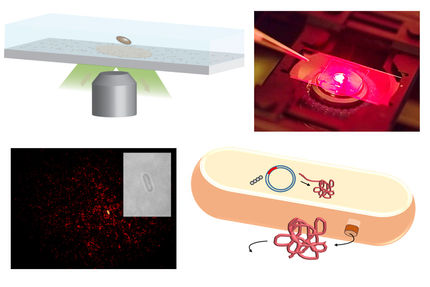Plastic biochip speeds up protein detection
Using fluorescent polymers to quickly detect attomoles of protein
A new, fast, and inexpensive way to test for medically important molecules, such the blood clot protein thrombin and faulty proteins present in Alzheimer's disease, could emerge from research published in the journal Advanced Materials. Mario Leclerc and his colleagues at Université Laval in Québec City, Canada, have developed a new type of sensor based on an array of DNA strands attached to a polymer film on a glass chip. When a protein sticks to this biochip DNA array, the attachment distorts the underlying polymer molecules, changing their optical properties and making them fluorescent. Their glow can then be readily measured with standard fluorescence detection techniques.
The biosensor can be built from specific DNA strands called "aptamers". These stick only to a specific protein and so can detect just a single protein, even in a mixture containing lots of other molecules that would otherwise interfere with the sensing process and give false positives. The new biochip has several other advantages over conventional protein sensors. These usually require sophisticated sample preparation and tagging the proteins with fluorescent molecules. Leclerc's biochip works with raw samples and needs no tags to work, and can be read using conventional DNA microarray readers.
The team tested the biochip using DNA responsive to the blood clotting protein thrombin and were able to detect a few attomoles of thrombin (or 3.6 × 10-13 g). Thrombin initiates the clotting process when you receive a cut or other injury. However, when this clotting cascade goes awry medical conditions such as thrombosis can arise. A quick and easy test for thrombin in a sample would provide medical researchers useful information in studying this and other related blood disorders.
Leclerc explains that in its present incarnation, the sensitivity of their biochip is limited by the relatively large size of the DNA spots in the array. So, he and his colleagues are currently looking at ways to make these spots much smaller (with a diameter of 100 micrometers or smaller) without reducing the biochip's specificity for a protein of interest. He also suggests that advances in microfluidic devices, which can easily integrate sample handling and detection for very small sample volumes (on the order of a few microliters), would allow them to speed up the analysis even more.
Currently, it takes about an hour for the biochip to "develop". The integration of several biochips for fast parallel testing of different proteins may also become a reality thanks to microfluidics. "If an aptamer has been found for a given protein, in principle we will be able to detect that protein," says Leclerc, "but more testing is needed to qualify that."
Leclerc adds that the technology could be applied to a wide range of diseases involving proteins. Many diseases are attributed to conformational changes in proteins, including Alzheimer's disease and transmissible spongiform encephalopathy, related to "mad cow disease", for instance. By combining the appropriate DNA aptamer and polymer, Leclerc says that future work could be lead to sensors for the proteins responsible for these diseases.
Original publication: Mario Leclerc et al.; "Protein Detecting Arrays Based on Cationic Polythiophene-DNA-Aptamer Complexes"; Advanced Materials 2006, 18, No. 20, 2703-2707.
Other news from the department science
These products might interest you
Most read news
More news from our other portals
See the theme worlds for related content
Topic world Protein analytics
Protein analytics provides a deep insight into these complex macromolecules, their structure, function and interactions. It is essential for discovering and developing biopharmaceuticals, understanding disease mechanisms, and identifying therapeutic targets. Techniques such as mass spectrometry, Western blot and immunoassays allow researchers to characterize proteins at the molecular level, determine their concentration and identify possible modifications.

Topic world Protein analytics
Protein analytics provides a deep insight into these complex macromolecules, their structure, function and interactions. It is essential for discovering and developing biopharmaceuticals, understanding disease mechanisms, and identifying therapeutic targets. Techniques such as mass spectrometry, Western blot and immunoassays allow researchers to characterize proteins at the molecular level, determine their concentration and identify possible modifications.
























































